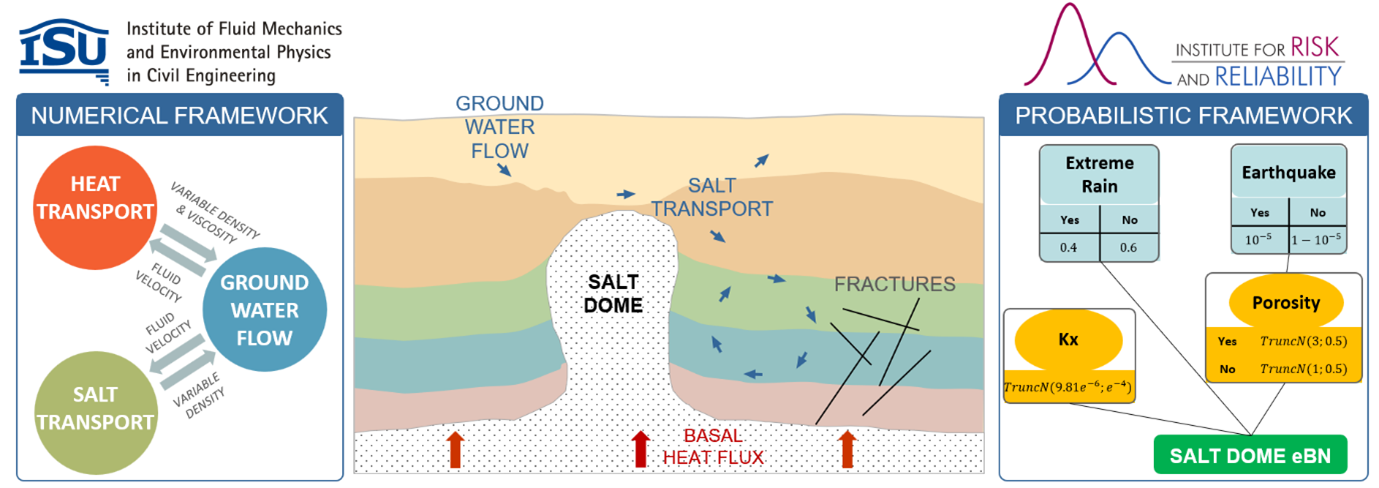¶ Risk-based Assessment of Salt Domes as Disposal Sites for Nuclear Waste
¶ Introduction
The RADON project is an innovative research initiative aiming at evaluating the feasibility and safety of using salt domes as disposal sites for nuclear waste. Salt domes are of interest due to their low permeability, high thermal conductivity, long-term geological stability, and ability to isolate hazardous materials. The project focuses on developing advanced methods for risk assessment, addressing uncertainties in hydrogeological, solute and heat transport processes that influence the safety of repositories in salt domes.
The primary objective of the RADON project is to provide a reliable framework for assessing risks associated with deep geological repositories in salt domes. This includes accounting for the impacts of variable density and viscosity in groundwater flow driven by temperature and salinity variations. By integrating numerical modeling, uncertainty quantification, and Bayesian Network approaches, the project to ensure comprehensive risk evaluations.
The RADON project is a collaborative effort between two partners at Leibniz Universität Hannover (LUH). The Institute for Risk and Reliability (IRZ) is responsible for developing the probabilistic framework, while the Institute for Fluid Mechanics and Environmental Physics in Civil Engineering (ISU) focuses on numerical simulations.

¶ Research targets
The project targets three major research areas:
- Enhanced Bayesian Networks (eBN): Development of a probabilistic framework to assess repository failure probabilities across various scenarios and considering both precise and imprecise uncertainties.
- Coupled Flow and Transport Modeling: Simulations of groundwater flow under density-dependent conditions, incorporating effects of solute and heat transport.
- Uncertainty and Sensitivity Analysis: Assessment of key transport parameters (e.g., dispersivity, diffusion coefficients) through the evaluation of their impacts on the predictions.
¶ Conclusion
The RADON project has established a robust methodology for risk assessment of salt domes as nuclear waste repositories. The integration of Enhanced Bayesian Networks and coupled flow models provides a comprehensive framework to:
- Quantify the impacts of uncertain transport parameters.
- Simulate realistic scenarios influencing radionuclide migration.
- Enhance the safety assessment of salt dome repositories under diverse environmental conditions.
Key insights emphasize the importance of precise estimation of transport parameters, including dispersivity and diffusion coefficients, and consideration of their uncertainty to ensure accurate risk evaluations.
¶ Outlook
Future research directions include:
- Expanding the model domain to include adjacent geological strata and larger-scale hydrogeological processes.
- Incorporating heat transport to investigate thermohaline flows in fractured-porous media.
- Developing advanced methods to break computational loops in imprecise probability evaluations, improving efficiency and scalability.
The RADON project paves the way for safer nuclear waste disposal solutions, leveraging cutting-edge modeling and uncertainty quantification techniques to address complex geological challenges.
¶ References
- J. Suilmann, J. Molson, and T. Graf (2025). Effect of mixing on groundwater age and life expectancy simulations in density-dependent flow. Accepted for publication in Hydrogeology Journal